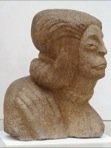Wunderkammer (Cabinet of Wonders)
dal 5/6/2008 al 16/8/2008
Segnalato da
Edvard Munch
Ernst Ludwig Kirchner
Emil Nolde
Oskar Kokoschka
Ronald B. Kitaj
Francis Bacon
Jean Dubuffet
Hans Arp
Max Beckmann
Niki de Saint Phalle
Eduardo Chillida
5/6/2008
Wunderkammer (Cabinet of Wonders)
Sprengel Museum, Hannover
Exhibition examines the transition between abstraction and representational art in 20th century. All of the works stem from the Sprengel Museum Hannover's collection. The show reflects the relationship between humanity, the environment people find themselves in and space through movement, responses to change as well as paradoxical conglomerations that exclude each other in the discourse between the abstract and the representational.

This exhibition, “Wunderkammer“, examines the transition between abstraction and representational art in 20th century painting and sculpture. All of the works on display stem from the Sprengel Museum Hannover's permanent collection. From that perspective, “Wunderkammer“, is also Ulrich Krempel's personal selection of art from the Sprengel Museum Hannover's collection which has not been on display for a long time
The show reflects the relationship between humanity, the environment people find themselves in and space through movement, full of the contrasts, responses to change as well as paradoxical conglomerations that exclude each other in the discourse between the abstract and the representational. The struggle to find new forms of expression, leading to new visual realities, is evident in the contrast between sculptural works by Bernhard Hoetger and Wilhelm Lehmbruck, or the archaic forms favoured by Alexander Archipenko, who also employed forms and methods from cultures beyond Europe. The contrast between rigid formality as in the work of Emy Roeder is vividly evident when juxtaposed with Henri Laurens' abstraction. Contrasting notions of figuration were explored by artists, such as Julio Gonzalez, Käthe Kollwitz and Kurt Schwitters, during the late 1930s and 1940s, reflecting the horrors of war and forced emigration experienced in Europe. The period that followed the war was of new visions of humanity and the figure, as seen in works by Hans Arp, Max Beckmann and Niki de Saint Phalle. Eduardo Chillida, on the other hand, then took these developments further by focussing on the spatial aspects of sculptural form.
Paintings by Edvard Munch, Ernst Ludwig Kirchner, Emil Nolde, Oskar Kokoschka, Ronald B. Kitaj, Francis Bacon and Jean Dubuffet both offer and chronologically expand the artistic impressions and interpretations of the relationship between the world at large, humanity and space over the course of the last century.
The “Wunderkammer“ exhibition examines a gamut of artistic styles and compares them by looking at how the relationship between figures and the space they inhabit changed over the course of the 20th century, as this became one of the most significant developments of the period. This exhibition, in view of all contemporary discourse, shows that these issues remain fundamental for contemplating the development of art.
The exhibition was made possible thanks to financing from the NordLB bank.
Sprengel Museum Hannover
Kurt-Schwitters-Platz, Hannover



